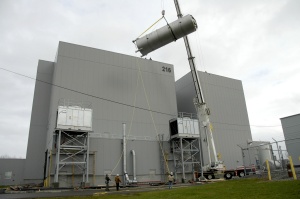Nov 18 2008
Six 25,000 gallon tanks will find a home in Xerox Corporation's (NYSE: XRX) EA toner plant in Webster, N.Y. this week. The arrival of the tanks will herald an era of more energy efficient digital printing, preparing for the production of Ultra Low-Melt EA Toner, a breakthrough product that can cut overall power consumption of digital printing devices by as much as 15 to 30 percent.
 Workers hoist a storage tank into place atop the Xerox EA toner manufacturing plant in Webster, N.Y. (Photo by Kevin Rivoli)
Workers hoist a storage tank into place atop the Xerox EA toner manufacturing plant in Webster, N.Y. (Photo by Kevin Rivoli)
Fusing the toner or sealing it on the page is the most power-intensive process in printers and multifunction devices, accounting for 50 percent to 80 percent of the total power used. In developing the Ultra Low-Melt EA Toner, scientists at Xerox Research Centre of Canada (XRCC) aimed to save energy by lowering the fusing temperature. The new toner melts at as much as 45 degrees Fahrenheit lower temperature than the EA toner now being used in current Xerox products, without compromising image quality or any other performance.
"This was the most difficult toner design we ever worked on," said Hadi Mahabadi, Xerox vice president and manager of XRCC. "We had to push the envelope to the limit to achieve lower melting temperature and higher gloss while keeping other performance the same as or better than current EA toner."
Scientists at XRCC initially developed the EA process at Xerox, and the Ultra Low-Melt EA Toner is their next generation product. Emulsion aggregation (EA) technology is a nanotechnology- based process that yields sharper image quality, higher reliability, and reduced toner usage in an energy efficient manufacturing process. In fact, pages printed with EA toner use 40 percent to 50 percent less material than those printed with older style toner. Until about five years ago, all Xerox toner was made by grinding plastic pellets into very fine particles - an energy intensive mechanical process.
Scientists and engineers at Xerox, in collaboration with colleagues at Xerox's partner company, Fuji Xerox, designed and tested many polymers before discovering polyesters that could be combined with other toner ingredients such as colored pigments and wax particles to form the Ultra Low-Melt EA Toner. Xerox scientists have applied for more than 35 patents related to discoveries they made while developing the new toner, and 10 have already been granted.
"With the new tanks, we expect the Webster plant to start producing the Ultra Low Melt EA Toner sometime next year," said Edouard Langlois, project manager for the Xerox Consumables, Development and Manufacturing Group. "Installation of these tanks will give this plant the flexibility to meet the demand for both first and second generation EA toners, and it will help Xerox deliver the most energy-efficient document management solutions for its customers."
Since EA toner was first introduced, Xerox and Fuji Xerox have designed more than 50 office and production products that use EA toner. The new low-melt toner will be suitable for all future products, from desk top printers to high-end office multifunction devices to high-speed commercial color presses. The Xerox 700 Digital Color Press, which was unveiled in May, is the first product to use the new toner, which is currently being produced in Japan.